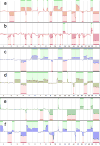Recurrent and nonrandom DNA copy number and chromosome alterations in Myc transgenic mouse model for hepatocellular carcinogenesis: implications for human disease
- PMID: 19389504
- PMCID: PMC2693875
- DOI: 10.1016/j.cancergencyto.2008.12.014
Recurrent and nonrandom DNA copy number and chromosome alterations in Myc transgenic mouse model for hepatocellular carcinogenesis: implications for human disease
Abstract
Mouse models for hepatocellular carcinoma (HCC) provide an experimental ground for dissecting the genetic and biological complexities of human liver cancer and contribute to our ability to gain insights into the relevance of candidate cancer genes. We examined, using spectral karyotyping (SKY) and array-based CGH (aCGH), seven cell lines derived from HCC spontaneously developed in transgenic Myc mice (Myc), and four cell lines established from tumors induced in nude mice by inoculation with the original Myc cells (nuMyc). All the cell lines exhibited gain of material from chromosomes 5, 6, 8, 10, 11, 15, and 19 and DNA copy-number loss from chromosomes 2, 4, 7, 9, 12, 14, and X. In addition, several recurrent chromosome reorganizations were found, including del(3), t(3;8), del(4), t(4;11), t(6;5), del(7), del(8), del(9), t(10;14), del(11), and del(16). Chromosome breakpoints underlying rearrangements clustered in the regions previously identified as important for the early stages of Myc-induced hepatocarcinogenesis. The results strongly suggest the importance of recurrent breakage and loss of chromosomes 4, 9, and 14 and gain of chromosomes 15 and 19 in mouse liver neoplasia. Genomic changes observed in Myc HCC cell lines are also recurrent in HCC developed in other transgenic mouse models, in mouse spontaneous HCC and derivative cell lines, and in preneoplastic liver lesions induced with chemical carcinogens. Overall, the present results document selective, nonrandom genomic changes involving chromosomal regions homologous to those implicated in human HCC.
Figures




Similar articles
-
Role of DLC1 tumor suppressor gene and MYC oncogene in pathogenesis of human hepatocellular carcinoma: potential prospects for combined targeted therapeutics (review).Int J Oncol. 2012 Aug;41(2):393-406. doi: 10.3892/ijo.2012.1474. Epub 2012 May 10. Int J Oncol. 2012. PMID: 22580498 Free PMC article. Review.
-
Nonrandom cytogenetic alterations in hepatocellular carcinoma from transgenic mice overexpressing c-Myc and transforming growth factor-alpha in the liver.Am J Pathol. 1999 Apr;154(4):1047-55. doi: 10.1016/s0002-9440(10)65357-6. Am J Pathol. 1999. PMID: 10233843 Free PMC article.
-
Y chromosome loss and other genomic alterations in hepatocellular carcinoma cell lines analyzed by CGH and CGH array.Cancer Genet Cytogenet. 2006 Apr 1;166(1):56-64. doi: 10.1016/j.cancergencyto.2005.08.022. Cancer Genet Cytogenet. 2006. PMID: 16616112
-
Array-based comparative genomic hybridization reveals recurrent chromosomal aberrations and Jab1 as a potential target for 8q gain in hepatocellular carcinoma.Carcinogenesis. 2005 Dec;26(12):2050-7. doi: 10.1093/carcin/bgi178. Epub 2005 Jul 6. Carcinogenesis. 2005. PMID: 16000397
-
Cytogenetic alterations in liver cell tumors as detected by comparative genomic hybridization.Pathologica. 2003 Apr;95(2):71-82. Pathologica. 2003. PMID: 12768875 Review.
Cited by
-
Spontaneous transformation of murine epithelial cells requires the early acquisition of specific chromosomal aneuploidies and genomic imbalances.Genes Chromosomes Cancer. 2012 Apr;51(4):353-74. doi: 10.1002/gcc.21921. Epub 2011 Dec 8. Genes Chromosomes Cancer. 2012. PMID: 22161874 Free PMC article.
-
Role of DLC1 tumor suppressor gene and MYC oncogene in pathogenesis of human hepatocellular carcinoma: potential prospects for combined targeted therapeutics (review).Int J Oncol. 2012 Aug;41(2):393-406. doi: 10.3892/ijo.2012.1474. Epub 2012 May 10. Int J Oncol. 2012. PMID: 22580498 Free PMC article. Review.
References
-
- Sandberg A. The chromosomes in human cancer and leukemia. 2. Elsevier Science Publishing; New York: 1990.
-
- Mitelman F, Mertens F, Johansson BA. A breakpoint map of recurrent chromosomal rearrangements in human neoplasia. Nat Genet. 1997;15:417–474. - PubMed
-
- Hanahan D, Weinberg RA. The hallmarks of cancer. Cell. 2000;100:57–70. - PubMed
-
- Thorgeirsson SS, Grisham JW. Molecular pathogenesis of human hepatocellullar carcinoma. Nat Genet. 2002;31:339–346. - PubMed
-
- Murakami H, Sanderson N, Nagy P, Marino P, Merlino GT, Thorgeirsson SS. Transgenic mouse model for synergistic effects of nuclear oncogenes and growth factors in tumorigenesis: interaction of c-Myc and TGF-a in hepatic oncogenesis. Cancer Res. 1993;53:1719–1723. - PubMed
Publication types
MeSH terms
Substances
Grants and funding
LinkOut - more resources
Full Text Sources
Medical
Research Materials

